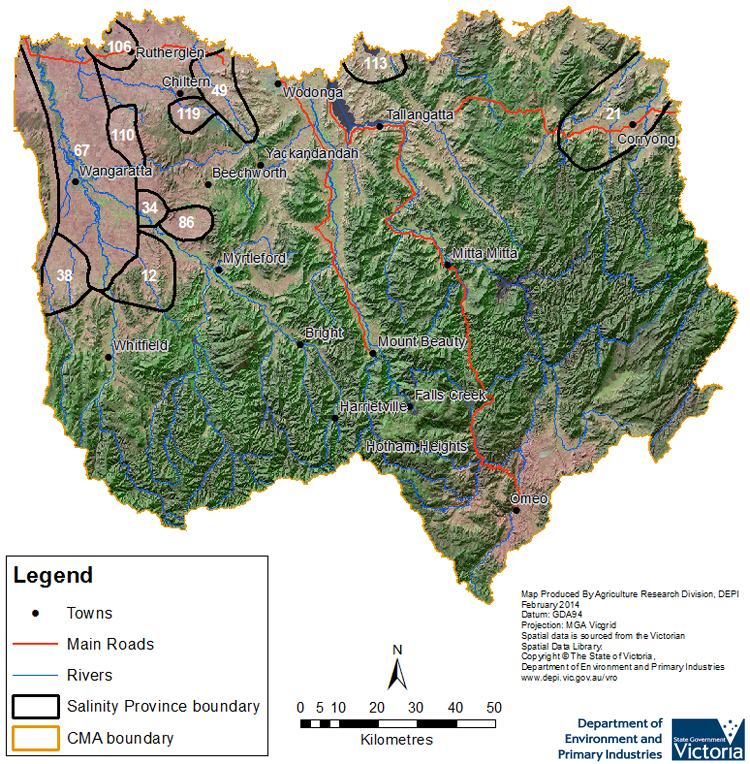Salinity Provinces in the North East Catchment Management Region
The North Central CMA Region covers about 13% of Victoria and extends from the steep rocky ridges of the Great Dividing Range in the south to wide alluvial plains in the north, terminating at the Murray River between the townships of Swan Hill and Echuca. The major river catchments are the Avoca, Avon-Richardson, Loddon and Campaspe Rivers. These rivers are typically deeply incised in the southern uplands and broad and spreading on the northern plains.
The Great Dividing Range influences the climate of the North East Region, which varies dramatically. Average annual rainfall ranges from less than 500 mm on the northern plains to more than 2000 mm in the alpine areas, much of this falling as snow. Approximately 60% of annual rainfall occurs between May and October. Temperatures also vary dramatically, depending on topography and location. Maximum temperatures greater than 38 °C are common away from the foothills in summer. In winter, maximums range between 10 °C and 16 °C in the flatter country, but reach close to zero in the mountain regions.
In the north, much of the region has been cleared for agriculture. The predominant agricultural land use is dryland pasture, which is used for livestock production (sheep for meat and wool, beef cattle and some dairying) with minor horticulture (traditionally tobacco, but now hops and vineyards). In the southern parts of the region are predominantly used for forest and parks.
Dryland salinity has emerged as one of the important natural resource management issues in the region. There are more than 200 individually mapped units1 recorded as saline, with the total area over 1300 hectares1 . Major salinity problems have occurred in the northwestern part of the Ovens catchment. Significant salinity discharges have been mapped along the lower Ovens and King Rivers (lower floodplain terraces) on the plain, and at Springhurst, Rutherglen, Murmungee, Everton and Indigo Valley in the upland areas. The catchment is also an exporter of salt and a contributor to water quality and stream degradation in the Murray River system.
The region has a range of local, intermediate and regional Groundwater Flow Systems (GFS). Each of these GFS presents unique salinity problems. For better monitoring and reporting salinity risk, 11 Salinity Provinces have been defined in the region, four of which are High priority.
The North Central CMA has an extensive range of online materials (maps and documents etc.) which outline the biophysical assets of the catchment, as well as their major risks (including soil and water salinity). This material also outlines the programs and projects currently being completed by the CMA to protect and enhance these assets. An example of this is the online data portal called the North Central CMA ‘iMap - Interactive Mapping System’, the link to which is provided at the base of this page.
Provinces displayed in this map are clickable or use the table of links provided

Province Name | No. | Area of Province (ha) | Recorded Soil Salinity Area 1 (ha) | Soil Salinity Area (% of SP) |
| Bobinawarrah | 12 | 23,090 | 73 | 0.31% |
| Corryong | 21 | 52,040 | 8 | 0.01% |
| Everton | 34 | 5,910 | 65 | 1.09% |
| Greta | 38 | 19,380 | 78 | 0.40% |
| Indigo Valley | 49 | 19,600 | 122 | 0.62% |
| Lower Ovens Valley | 67 | 104,860 | 557 | 0.53% |
| Murmungee | 86 | 9,180 | 260 | 0.28% |
| Rutherglen | 106 | 10,380 | 117 | 1.12% |
| Springhurst | 110 | 10,530 | 132 | 1.25% |
| Talgarno | 113 | 12,210 | 7 | 0.06% |
| Upper Black Dog Creek | 119 | 7,880 | 3 | 0.03% |
1 Please Note: The ‘Recorded Soil Salinity Area’ and ‘number of individually mapped units’ indicated in the CMA text and/or table, comprises the total geographic area or number of sites that have been mapped as having, or showing symptoms of dryland soil salinity at some time (past or present). As dryland salinity occurrence in the Victorian landscape exhibits many different levels of severity and can change due to climate, landuse and vegetation, previously mapped areas may no longer be showing symptoms. In addition, as not all parts of the state have been mapped, or mapped in the same way, the mapping may not have captured some occurrences.
Recorded soil salinity mapping used for these pages does not cover irrigation regions. Instead, depth to watertable and watertable salinity mapping has been used to convey the threat of high watertables on soil waterlogging and/or soil salinisation.
Please contact the Department, your Catchment Management Authority or your rural water provider for more information about salinity in your location.
Links to further reading and material related to the North Central CMR
North East Catchment Management Authority region on VRO
North East Corangamite Catchment Management Authority
North Central CMA ‘Regional Catchment Strategy ’ (RCS)
North Central CMA ‘iMap - Interactive Mapping System’
Information about bores and groundwater resources in the North Central CMA can be found on the Visualising Victoria’s Groundwater (VVG) website


